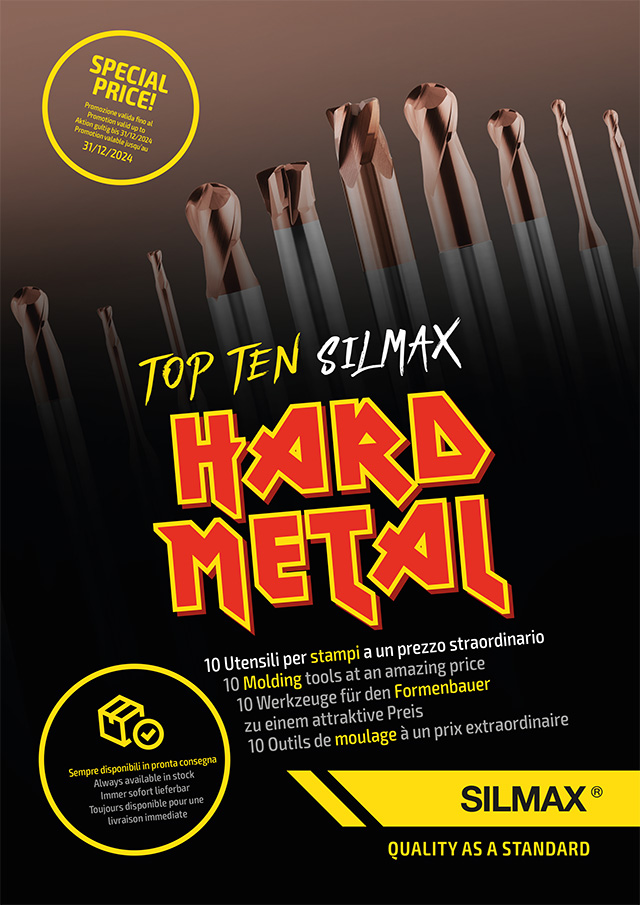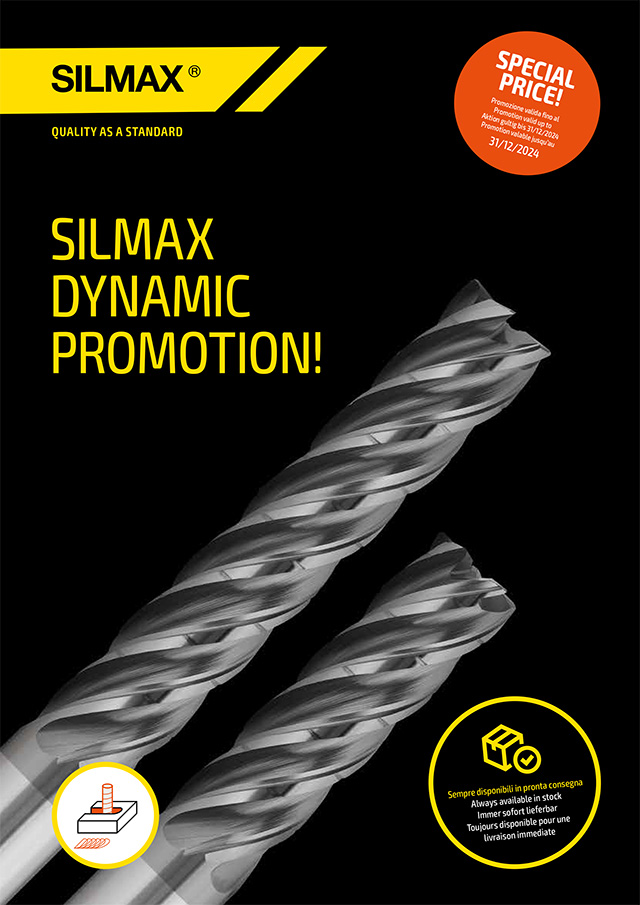Silmax proposal
Silmax offers a wide range of PVD Coating solutions based on different milling and drilling machining operations.
Coatings Characteristics
| Balinit® Futura Nano | Balinit® Alcrona Pro | Balinit® Latuma | Balinit® Tisaflex | Balinit® Alnova | Diamond | AluSpeed® by Cemecon | X-Pro | |
|---|---|---|---|---|---|---|---|---|
| HMF | HMG/NIG | HMC | HMH | HMY | HMD | HMA | HMX | |
| Chemical composition | TiAlN | AlCrN | AlTiN | TiSiN | AlCrN | Diamond | TiB2 | AlCrN |
| Hardness (HV05) | 3300 | 3200 | 3300 | 3600 | 3200 | 8000-10000 | 3000 | 3200 |
| Thickness (µm) | 1-4 | 2-4 | 1-4 | 2-4 | 2-4 | 6-12 | 2-4 | 2-4 |
| Maximum operating temperature (C°) | 900 | 1200 | 900 | 1200 | 1200 | 600 | 800 | 1200 |
| Application | UNV | HPC UNV | HRC TIS | HRC | TIS | CMPA | ALU | PHM |
Coating choice based on material to be worked
| Materials | Balinit® Futura Nano | Balinit® Alcrona Pro | Balinit® Latuma | Balinit® Tisaflex | Balinit® Alnova | Diamond | AluSpeed® by Cemecon | X-Pro |
|---|---|---|---|---|---|---|---|---|
| HMF | HMG/NIG | HMC | HMH | HMY | HMD | HMA | HMX | |
| Steel | ●● | ●●● | ●●● | ●● | ● | – | – | ●●● |
| Hardened Steel | – | ● | ●●● | ●●● | – | – | – | ●● |
| Stainless Steel | – | ●● | ●●● | – | ●● | – | – | ●●● |
| Superalloys | ● | ● | ●● | – | ●●● | – | – | ●● |
| Aluminium & Alloys | – | ● | – | – | – | ●● | ●●● | ●● |
| Thermoplastics resin | ● | ● | ● | – | – | ●●● | ●● | ●● |
Technologies

Cleaning
Novatec Monocamera 2CRD400
Cleaning operations are carried out using the latest generation systems with combination of ultrasonic technologies, surfactants and vacuum drying, resulting in particularly efficient cleaning of tools with complex geometries (for instance internal cooling holes).

PVD Coating
Oerlikon INNOVENTA Kila
last generation of medium-large coating system that guarantees higher productivity.
- 12-trees carousel
- Last generation software in batch control
- Loading range Ø703×400 mm (up to 720 Kg)
- Temperature control based on substrate conditions
- 8 sources with possibility of alternating use for multilayer coatings

PVD Coating
Oerlikon INGENIA
Small coating system that can guarantee excellent speed and flexibility in process.
- 4-trees carousel
- Process speed
- Flexibility (up to 6 different process in 24 hours)
- Loading range Ø360×400 mm (up to 200 Kg)
- 6 sources with possibility of alternating use for multilayer coatings

Quality control
Microscope OPTIKA B-350
Optical microscope equipped with measurement software. Employed in coating thickness and adhesion evaluation.

Quality control
Calotester CSM Instruments
Special instrument which generates a surface erosion of the coating capable of determining the thickness of the deposited coating.

Quality control
Durometer Affri Sistem 206-EX
Instrument used on special specimens to generate the impression that will return coating adhesion on substrate value.
What is PVD coating?
PVD stands for Physical Vapor Deposition and consists in deposition of a selected material thin layer to give substrate the desired characteristics for a specific application. The PVD treatment applied to the tools allows to obtain a relevant increase in tribological, thermal and mechanical properties at high operating temperatures.


Results
Optimum results of PVD coating are obtained with:
- careful substrate preparation
- correct tool’s handling
- batch loading and fixtures management
- coated surface post-treatments
PVD process
Cleaning
First step in PVD process is substrate cleaning. This phase is of fundamental importance to obtain a high quality PVD coating.
Employed technology involves a combination of ultrasonic and surfactants in temperature alternating with rinsing with specially treated water (softened and osmotized) in order to completely remove the impurities present on the surfaces.
Basically mechanical action of ultrasonic pressure waves destroys the saturated layer of surfactant on the surface of the tools to be cleaned so that on the surface itself «new» surfactant can act of and the cleaning process proceeds.
Conclusive phase of the cleaning process is tools drying. The drying step is carried out at high temperature and under vacuum, the vacuum generation ensures optimal drying and cleaning even of the «hidden» parts that can be present in complex geometry tools or internal lubrication holes.
Once the cleaning procedures have been completed, parts to be PVD coated can be handled only with protective gloves in order to prevent contamination of the same.
- A. substrate
- B. insoluble contaminant
- C. coupling media
Coating
Coating phase takes place in PVD coating systems and consists of four main phases that make up the entire coating cycle: heating, etching, coating and cooling.
Heating
In order to receive the coating, substrate must reach a certain temperature based on type of coating that is to be deposited. Inside coating chamber heating takes place with combined action of: heating by radiation (electrical resistances) and hydrogen plasma heating (hydrogen plasma collides on the tool surface by means of an electrical potential difference and stabilizes the temperature).
- A. Generator
- B. Tools
- C. Argon
- D. Filament
- E. Magnetic field
- F. Magnet coils
- G. Vacuum pump
Etching
Task of Etching phase is to «activate» tools surface to receive coating. This phase occurs by means of an argon gas plasma that is generated inside the chamber; Argon ions are attracted to the surface to be coated by means of an electrical potential difference and colliding on it remove an infinitesimal layer of material and possible oxide present on it. In this way the surface is ready to receive the coating layer (Coating).
- A. Generator
- B. tools
- C. Argon
- D. Filament
- E. Substrate voltage
- F. Auxiliar anode
Coating
Coating step is that phase in which coating material is deposited on substrate. The acronym PVD or Physical Vapor Deposition means that there is a physical vapour deposition of the coating material on the substrate to be coated.
Inside coating chamber are inserted «Targets» composed of material that you want to deposit allocated in what are usually called «sources». When the Coating phase starts sources are triggered by means of an electric arc that is confined to the surface of the Target. Electric arc generates such a high temperature on target surface that the material of which it is composed evaporates.
Evaporated material binds to the reactive gas Nitrogen present in the process chamber (generating nitrides) and this combination is attracted to the substrate to be coated by means of a difference in electrical potential. Time of coating phase determines the coating thickness that will be deposited on the substrate.
- A. Generator
- B. Tools
- C. Bias voltage
- D. Arc sources
- E. Nitrogen
- F. Vacuum pump
Cooling
Last cycle step is cooling; the chamber and the tools inside must be brought back to a temperature such that contact with the atmosphere outside the chamber does not create damage and/or oxidation. Cooling is carried out by introducing gases such as Helium or Nitrogen into the process chamber which cool the substrates safely.

